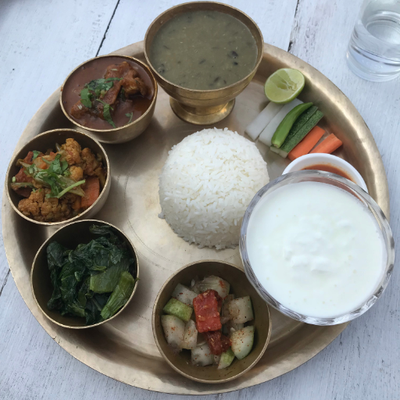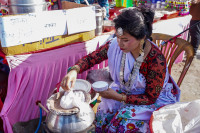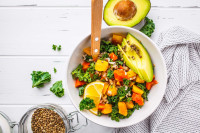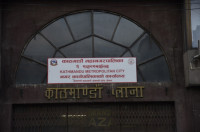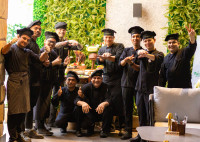Food
Western Tandoori provides the bhatti experience, without any risk and any flavour
Western Tandoori is cheap and generous, but don’t take TripAdvisor’s high rating as gospel.
Hantakali
Western Tandoori’s reputation precedes itself, its name whispered among tourists as though it’s a local secret only they know. It sits on one of Thamel’s peripheral arteries, tucked between local restaurants, watering holes, and lesser-frequented trekking stores.
Western Tandoori is just as unassuming as the nearby Bismillah Halal Restaurant. There’s a tandoor at the door, it’s cramped, frequented by locals and not the cleanest place in the world—just like Bismillah. But what it has over that eatery is it’s closer to the tourist hub’s heart and, perhaps, its more modest pricing.
The Amrit Marg restaurant is rated 18th on TripAdvisor—not a good rubric for a restaurant’s quality, given its bizarre algorithms, but evidence of popularity nonetheless—which is astounding, considering the site has some 900-odd rabble-rated restaurants.
A handful of travelling germaphobes have rated the place terribly, but an overwhelming horde says the food is exceptional. ‘Delicious’, ‘best’ and ‘tasty’ are the oh-so-original adjectives that line pages of gushing reviews for this ‘hole-in-the-wall’ restaurant. Going by the volume of praise, Western Tandoori definitely warranted a visit.
Sitting down at this restaurant is just like at any other Kathmandu spot: a disinterested waiter approaches, asks what you want and returns in a matter of minutes with a cheap meal.
Ordering an assortment of run-of-the-mill dishes—palak paneer, chicken masala and mutton curry—anticipation of a delicious meal runs high, but there are minor twangs of doubt because no one should really trust TripAdvisor. The place is popular, as customers order thali sets or naan and curry, with several young waiters sliding through the shoebox space with arms laden.
One dedicated tandoori-making flunky slaps bread on the fire-side counter, presses the bread out like a pizza and slaps it into the barrel with a pillow. Hot air extrudes bubbles on the bread, before its pulled out, whacked a few times with a cleaver, and dropped on to someone’s table. Foreigners gaze in wide-eyed glee but locals sit disinterested, waiting for their sustenance.
The dishes arrive in steel canoes, spilling their overflow on the table, then a few baskets of tandoori breads: lachha paratha, garlic naan and butter naan. The paratha, crushed to reveal it’s doughy striations, is piping hot. The leopard-spotted garlic-flecked naan is inviting, but the butter naan is anaemic.
No time to waste, bread is broken and dunked. The first taste of the spinach dish has the earthy palak-ness that one would expect, and tastes of the wonderful convergence of spinach and ghiu. But the chunks of paneer, enveloped by viscous green sludge, wreck the dish—they’re chalking and squeaky, thanks to either too much time in the frier or the open air. They taste dehydrated, and in turn, somehow dry out the mouth. While the dish is lacking in its execution, there is value in the meal, just given the sheer number of paneer cubes in the curry. But no restaurant can substitute price for quality when dishes are so simple. The next dish, mutton curry, doesn’t save the affair.
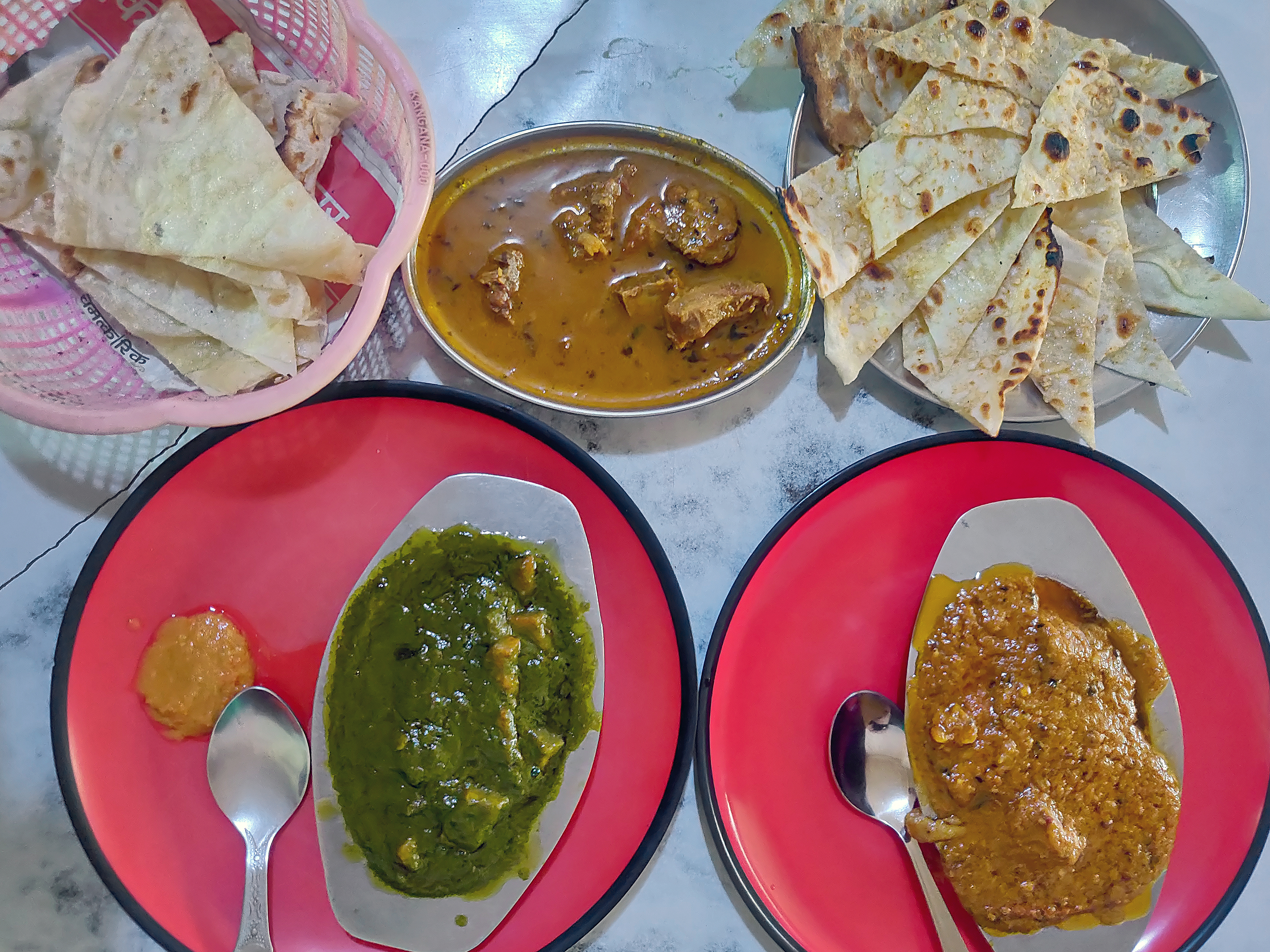
About six large chunks of mutton sit in an aqueous coriander-mottled gravy. Things look promising, but one spoonful is all it takes for salt to overwhelm the palate. The general flavour of the curry, or what the restaurant is trying to achieve, is inconceivable because sea-like waves flood over every spice in the mix. It’s a wonder the mutton wasn’t buoyed by the gravy’s Dead Sea levels of salt.
The chicken masala, an oddly sour and sweet curry flecked with black seeds, is the highlight among the dim dishes. Recovering from the saltiness of the previous affair, the contrasting flavour is refreshing. The chicken is slightly overcooked, and speaks to an issue that is only revealed after the meal, and the gravy is thick and mouth-lining.
What none of these dishes had, among many other things, is spice. The two meat dishes were served alongside a tingly achaar, to be used with personal discretion, but the dishes were so far from spicy—they verged on the bland.
Back to the bread, the vessels with which one should consume these dishes. While the ream of garlic naan looks generous, the hollow cheeks bubbling from its surface only hide its scrawniness. Buckling under the weight of gravy, the bread loses any semblance of taste. The pillowy texture one desires is nowhere to be seen, and any mopping quality is rendered out of existence. The butter naan is even more disappointing, chewy and lifeless, while the lachha paratha is the only bread that really hits the mark. It’s crispy and chewy, and peels off nicely.
Peeling out of the seat, to poke a head into the kitchen, one can see why the food is the way it is. A few buckets sit next to the burners and pans, ready for dropping in and cooking. The sauces are all precooked, as is the meat. Because it’s all prepared beforehand, the meat has a tendency to be dry, overcooked or same-same. While this surreptitious practice might be common to Kathmandu’s many tandoori restaurants, the blatant flavour similarities may leave an educated palate wanting.
Spilling out onto the streets of Thamel, it takes some deliberation to figure out just why this restaurant is so popular. There were six staff members in the restaurant, for six tables, and they were busy. There were locals and foreigners, and everyone was happily eating.
Western Tandoori is an institution for two reasons. For locals, it’s an extremely affordable feed that arrives faster than a McDonald’s Big Mac. It’s probably one of the most affordable spots in the tourist-laden, relatively expensive, neighbourhood—an obvious favourite for locals is the Rs 150 vegetable dal bhat.
For westerners, it’s the closest thing for many of them to a real local Nepali restaurant experience. If Western Tandoori were in any other corner of the city, without the verification of other foreigners, many tourists might walk past without entertaining the prospect of eating there.
The restaurant acts as a placebo, providing the bhatti experience without any worry about the level of heat. Plus its price point is a massive draw for the backpacking crowds that fill Thamel’s hostels.
These visitors come to the developing world, and they want an experience befitting their preconceptions of what the country should be like—not just croissants and cappuccinos at Himalayan Java. But they also want a guarantee that they won’t contract anything as a result of their adventure.
So, with TripAdvisor’s affirmation, they voraciously consume Western Tandoori’s curries in ‘rough’ circumstances, vainly believing the food is as authentic as it comes. But, looking at the food in an honest light, it provides what it says on the can: Western Tandoori. Perhaps patronising such an institution with lofty expectations was a futile pursuit from the beginning. After all, it is called Western Tandoori, and it serves western-style tandoori to salivating foreigners and hungry locals who want to fill a hole. It’s not spicy, complex, or particularly interesting, it’s what the western palate has been taught what Indian food is. And it’s cheap.
Western Tandoori
Rs 50-400 pp
Food: ★
Ambience: ★★
Value: ★★★
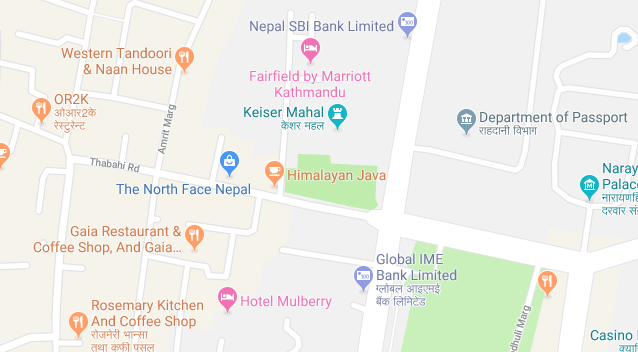




 16.12°C Kathmandu
16.12°C Kathmandu